Table of Contents
- Introduction
- Methods & key findings
- Community and consumer trends — Are new behaviors here to stay? Time to find out.
- Strengthening your team — Not ready for new hires? Build skill sets from within.
- Marketing — Optimizing online and increasing your reach is more important than ever.
- Enrichment program offerings — What's working? Outdoor? Online? We review the numbers.
- Child care — Your community is online. Are you meeting them there?
- Faith in industry rebound — A positive trend in industry growth, but the work starts now.
Introduction
A unique year — a different report.
Turning to 2021, the after school industry faces a unique and evolving year. Things are and will continue to be in motion and thus hard to predict. However, as the industry prepares to ascend following the challenges of 2020, we wanted to research, converse and inquire to gain insight for our 2021 After School Report with the goal of creating a tool to help you rise above the uncertainty of the upcoming year.
We took a slightly different approach to our report this year. In addition to our traditional survey data, we explored and pulled information from industry-leading after school programs and sources. Specifically, to help gain perspective, we analyzed more than 165 child care and enrichment programs nationwide to uncover how they’re identifying and planning to achieve success — through technology, marketing, communication, staffing, safety and more — in 2021.
You’ll see the results of our conversations and research in our 2021 After School Report. We hope you feel inspired to innovate, connect, and create this year after viewing the report.
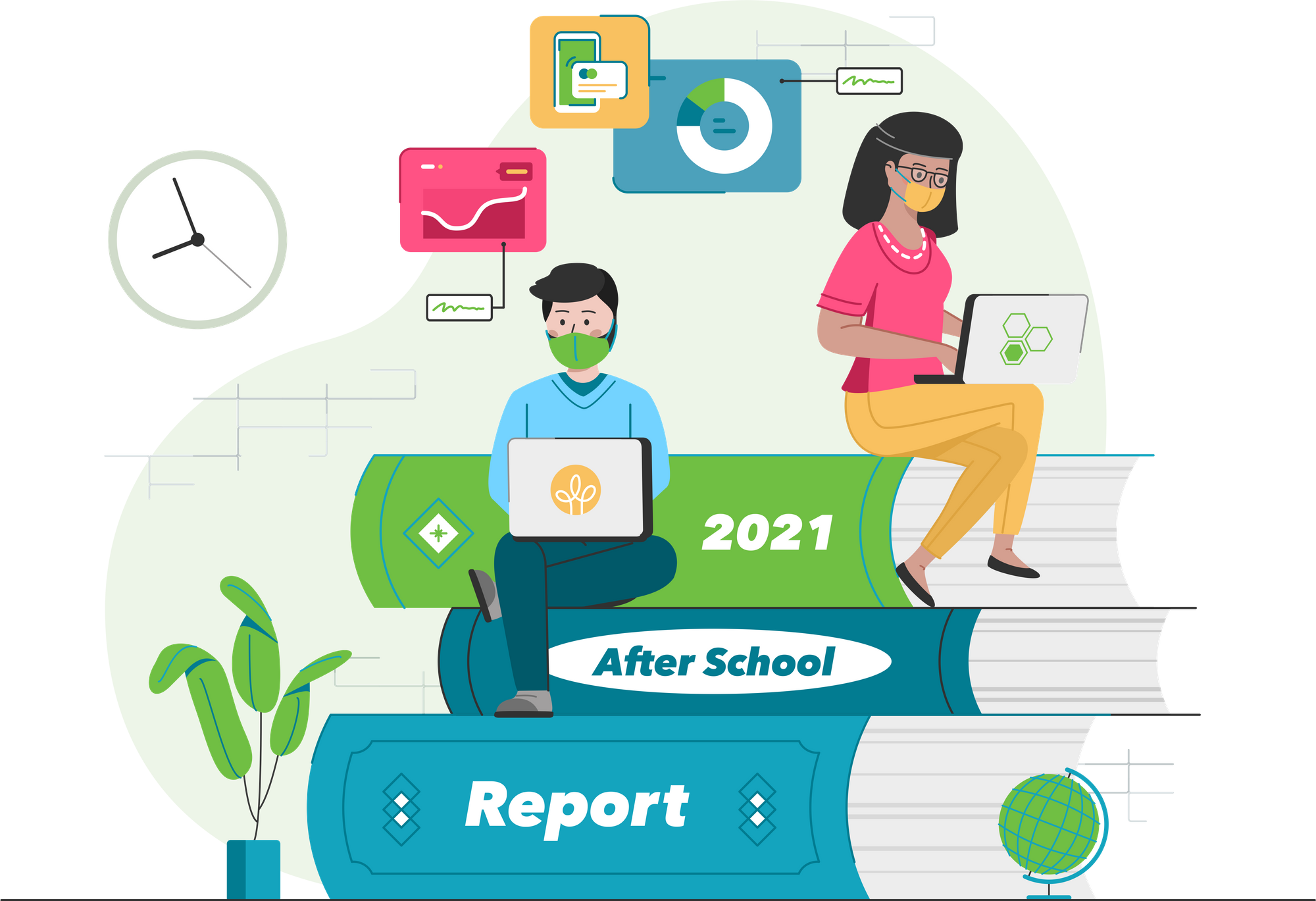
Methods & key findings
To better understand where the after school industry is headed during this vital year, we:
- Reviewed more than 165 child care and enrichment programs around the country, compiling data from their program catalogs
- Surveyed nearly 90 customers throughout 2020 to discuss schedule types, new technologies and how they’re growing in 2021
- Conducted market research to observe industry and consumer trends in technology, payments, employment, marketing and more
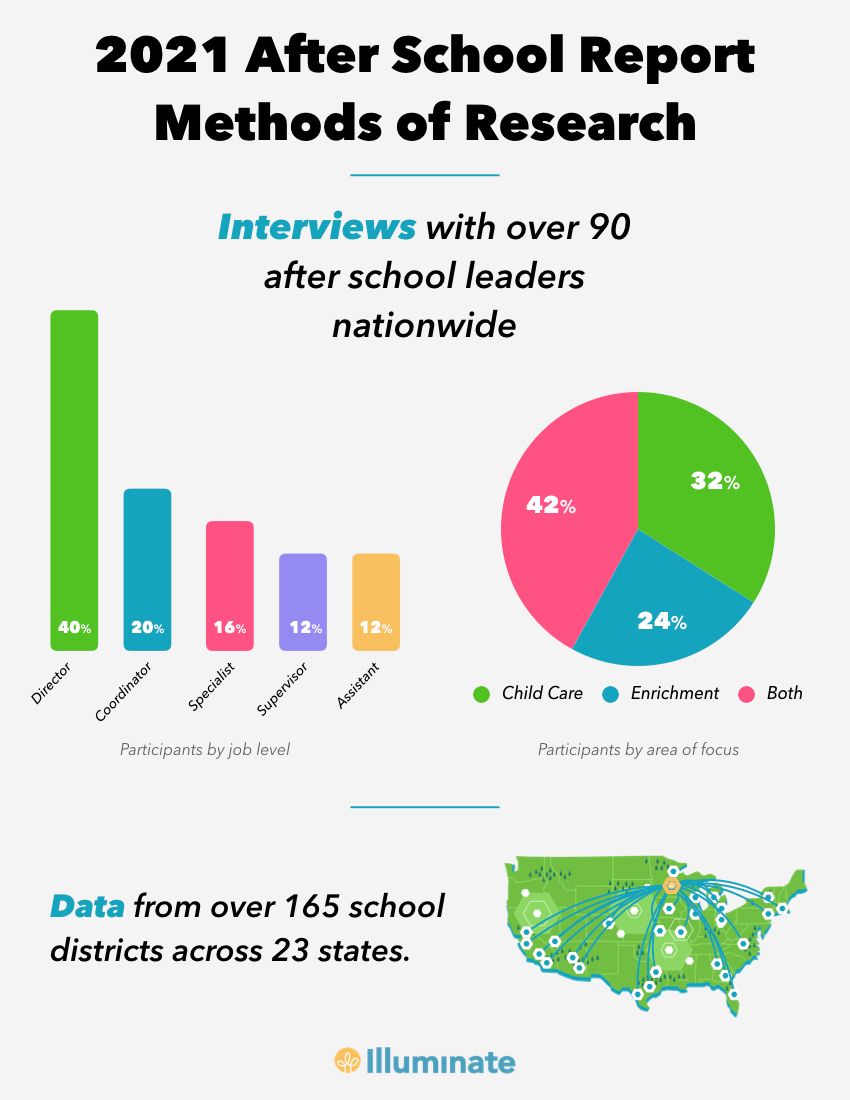
Key findings summary.
Overall..
- 2021 is the year of monitoring community behavior, particularly regarding digital payments and overall technology use
- Strengthen and empower your team through skills acquisition and development opportunities
- Online and outdoor enrichment offerings rose to prominence and are expected to be significant course formats in 2021 — but how significant is the question
- Child care programs have an opportunity to “welcome” parents and children back, and optimizing online presence is how to do it
- Have faith in, and be prepared for, industry rebound
Community and consumer trends
Are new behaviors here to stay? Time to find out.
Across every industry, behaviors, trends and everyday life for consumers changed in 2020. After school was no different. New realities in health, home and safety influenced how your communities registered, paid and took part in your programs and how you offered, scheduled and marketed your programs.
In 2021, the big opportunity is understanding which of these new community behaviors are here to stay. As you navigate eventual transitions and work toward fully re-opening your programs, are communities going to remain inclined to register, purchase and partake in programs digitally? It’s incumbent for after school programs to recognize and measure community trends and behavior in 2021 and the impact it will have on their teams.
Let’s dive deeper to see what this means for your program.
Program Registration — Accessibility, availability and convenience are cited as top drivers for consumer decision-making, and they will continue to drive behavior in 2021. Last year, consumers gained an expedited level of experience and familiarity registering for many things online — in all aspects of their lives. According to UsabilityGeek, in many situations, websites and applications will overburden their form field in an attempt to obtain the most data about their users. This commonly results in a frustrated and irritated user.
Build registration forms that are easy to work through, pull information from past purchases, and have a professional and personal feel and have a mobile friendly design.
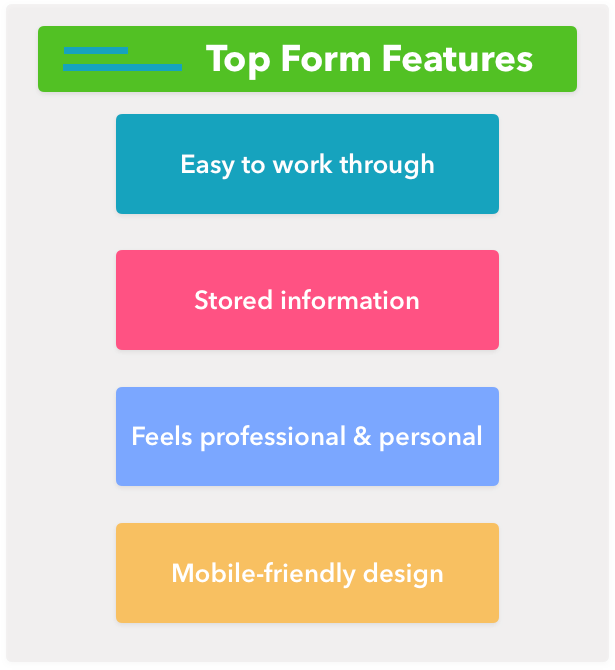
Payments — Across the board, online purchasing accelerated into 2021. Whether entertainment, household items, groceries, or apparel, online purchasing increased by 14-50%, depending on the category. It’s no secret that the coronavirus pandemic has accelerated an already growing eCommerce market.
To keep pace with your community and your competition in the market, it will be important to offer digital payments for your programs, if you are not already. According to E-Commerce Times, and a consumer billing and payment trends and behaviors survey by ACI Worldwide, 70% of respondents prefer digital payment options such as website and mobile app channels to pay one-time bills.

And we see these preferences correlate into specific types of digital payments, like digital wallets. For example, according to AppleInsider, Apple Pay, one of the fastest-growing digital payment methods, was activated on 507 million iPhones as of September 2020. Year-over-year, Loup Ventures estimates that 507 million iPhone users have activated Apple Pay, up from 441 million in September 2019. That represents an estimated yearly growth of 15%, driven in part by the rise in contactless payments during the coronavirus pandemic.
Technology use — Overall, it’s assumed the increase in eCommerce will continue. As we’ve seen through registration and payment data, entire generations turned to online shopping and technology as a whole this past year. Familiar with registration and purchasing processes, many rely on technology for purchasing, communication and enrichment. And these aren’t just younger generations. In 2019, the World Economic Forum reported that approximately 70% of seniors are now connected online, using digital devices to stay informed, connect to friends and family, shop, make travel plans, and make reservations for travel and transportation.
What does all of this data mean? Opportunities for before and after school and enrichment programs to reach news audiences and develop new customers are expanding fast.
Strengthening your team
Not ready for new hires? Build skill sets from within.
Recruiting and retaining staff is often a prominent challenge for the after school industry. Unfortunately, the coronavirus pandemic compounded on this challenge with financial uncertainties, budget constraints and even sudden shifts to remote-work environments. However, as these factors disrupted teams in 2020, 2021 presents an opportunity to create a strong foundation for your team leaders and staff through professional development.
As many programs will remain unable to bring on new additions to their teams in 2021, building your team skills from within is how you will create efficiencies and build talent. Whether professional certifications or specific skills and leadership training or through new tools, employees want to grow. Luckily, there are many free or affordable tools and resources out there to do so. Empower employees by researching and offering these opportunities and digital tools you can use, and you will increase the skill and efficiency of your team.
When speaking with the after school industry, it was evident that many programs adapted new technologies this year. Many of these technologies can lead to better organization, communication while building talent within your team.
Adapting to new technologies can seem daunting, but it is a key component of creating efficiencies for your team which is a big theme for 2021. Below are some favorite new technologies of the after school industry and beyond:
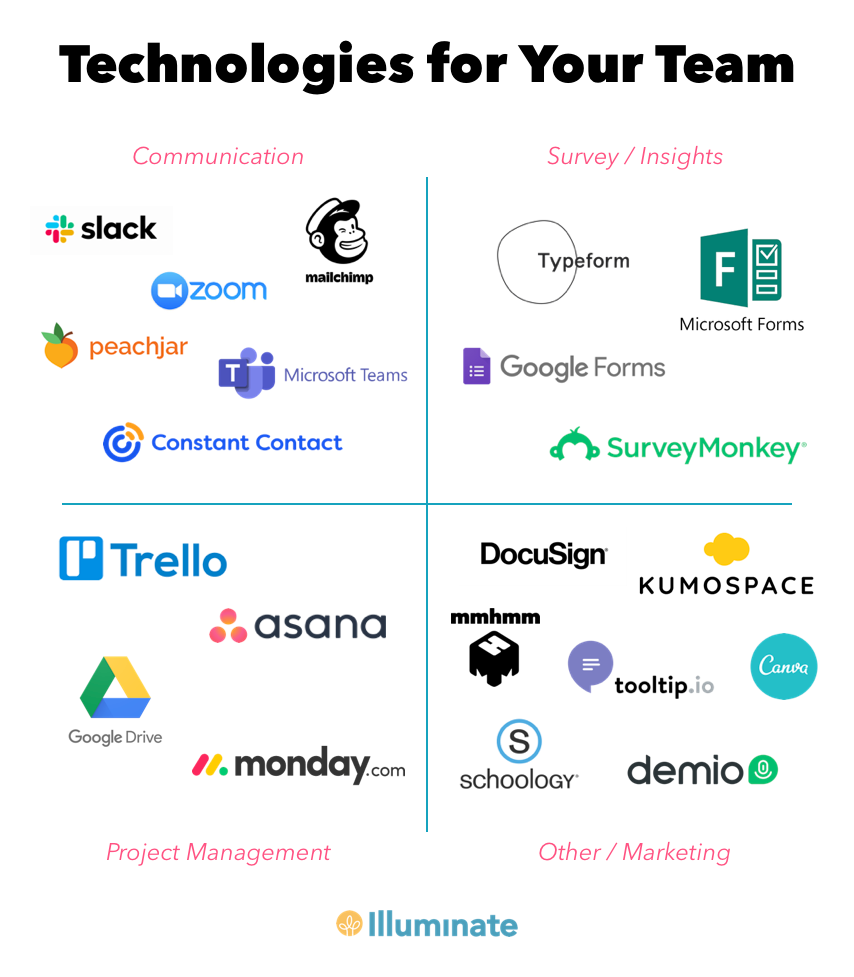
In addition to new technology, it will become imperative to reserve time throughout your week for exploration and professional development. As day-to-day tasks pile up, professional development is one of the first things sacrificed. Whether you lead a team or are a strong contributor, take time each week to explore new tools and ways to grow.
LinkedIn has become a powerful professional development tool for this. Follow companies, blogs and individuals who inspire you. Joining groups, following hashtags (#leadership, #education, #technology), and following organizations is an effective way to network and connect your timeline with inspiring words and work.
If you’re unsure of a place to start, Google or search on LinkedIn for professional development opportunities in your desired skill set. Odds are, you’ll quickly find light, free courses to build talent. The link below will provide some additional online courses to boost your professional development.
Skillscouter: Top 17 Free Online Courses With Certificates
Marketing
Online optimization is more important than ever.
While course formats are diversifying, programs have a significant opportunity to communicate and market these courses effectively. Community members are working, communicating, shopping and more through digital channels. They’re becoming tech savvy, and thus, have high expectations for online experiences. These increased expectations prove marketing is a growing opportunity for enrichment and child care programs. You can begin forming a plan for your program by breaking it down into a few principles.
Three Marketing Principles to help guide your program in 2021
Understanding your top customers and community base — No one knows them better than you. Leverage this knowledge and information you’ll gather throughout the year to guide your messaging and which channels you’ll use.
Create messaging and packages specifically for them — The goal of your marketing should be to create experiences and offerings that connect with community members on an individual basis.
Surround it with a dynamic digital experience — Make it a priority to fully optimize your program’s online presence (your website, social channels, etc.) Your programs be easy to find, understand and interact with online. This can be achieved through professional development, research, or building skill sets on your team.
Social media channels can do wonders for a program’s visibility. However, after conducting website research of programs around the country, we found that very few were leveraging some of the most popular social platforms on their program website to market their courses. Specifically:
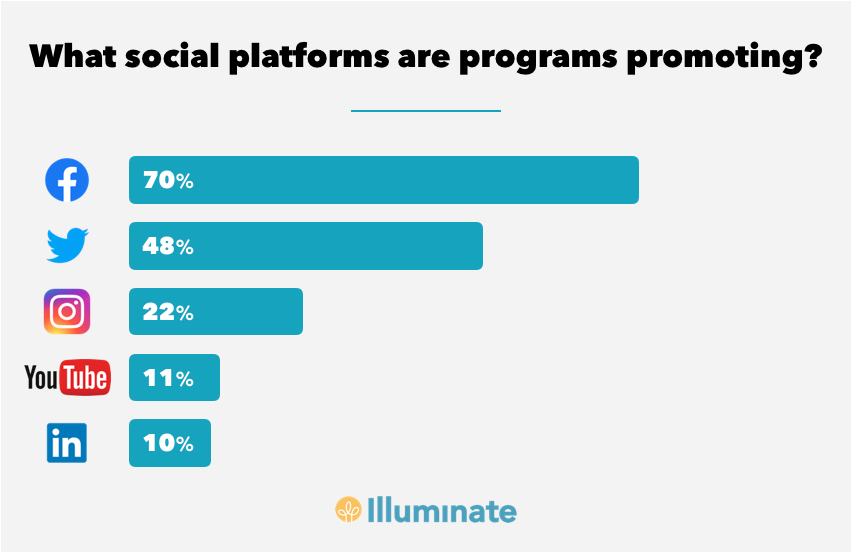
Insight💡 — Your program must look beyond just Facebook to market and communicate to your community. Although proven effective in the past, we hear from enrichment programs that more and more people leave the platform.
“We hear from our community that they’re no longer on Facebook - which was one of the primary ways we promoted our programs.”
Social media can’t and won’t replace powerful marketing and communication tools like direct mail or email. However, these channels are another strong tool to add to your tool box and should be created and connected to your site. Not only can social platforms be a communication method, they provide the ability to educate your community on your program, your values and your impact. In today’s world of everything-all-the-time, trust and connection will keep your programs top of mind.
Need some additional insight into marketing your programs this year? View more marketing and web optimization strategies in Eleyo’s Registration Workbook.
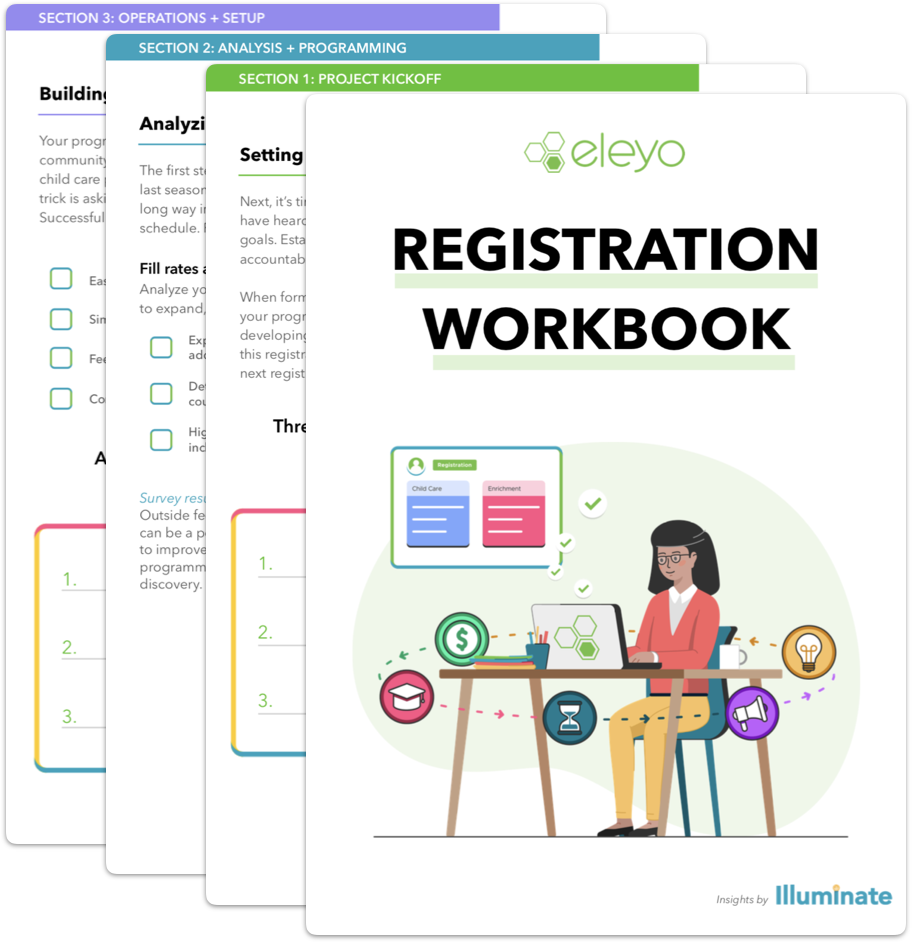
If you talk to the people who support you during normal times, you’ll find out what they are looking for now. Then, just get creative.” — Jill Korsok, Pepper Pike, OH
Cool web things that caught Eleyo's eye.
Throughout our program and market research, we kept tabs on some of the fun things we found!
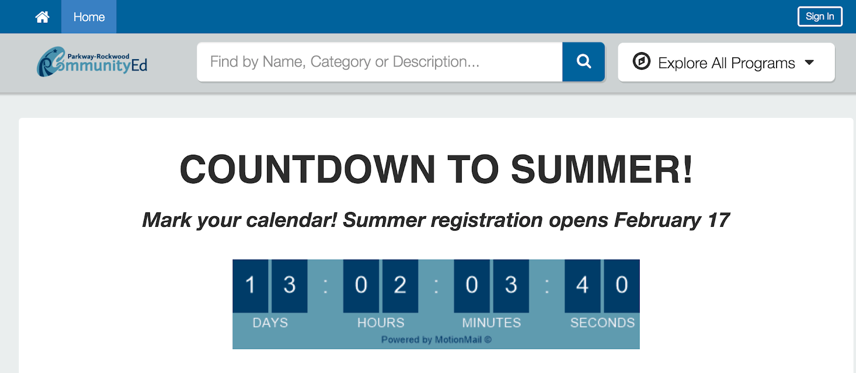
- Countdown to summer — Parkway & Rockwood Community Ed
- Using imagery that creates a sense of place — Lake Superior Community Education
- Pinterest pages — Community education programs are beginning to leverage this creative, highly visual social platform
- Popular course rankings — Programs are making it easy for community members to find their most popular courses
The importance of graphic design is emerging across the digital experience, and there are some awesome tools to help you build, organize and package creative and compelling visuals!
- Canva — Graphic design platform, used to create social media graphics, presentations, posters, documents and other visual content.
- Noun Project — Website that aggregates and catalogs symbols that are created and uploaded by graphic designers around the world.
- Keynote or PowerPoint — Software applications that allow you to package and design a variety of different communications- everything from PDFs and Handbooks to ads and banner images for your site.
Enrichment program offerings
What's working? Outdoor? Online? We review the numbers.
The world of after school enrichment has always been vast, but COVID-19 has opened up even more possibilities. Out of necessity, enrichment programs around the country instituted the rise and prominence of virtual and outdoor course offerings in 2020. As discussed in community behavior, it’s expected that many of the successful and popular courses created last year will remain in course catalogs in 2021 as communities are now used and may prefer taking courses in these formats. In particular, we expect a continued rise in senior enrichment course popularity. For the time being, it's simply safer for seniors to partake in courses virtually. Now and in the future, virtual courses allow senior members of your community to remain involved in enrichment, but without the barrier of needing to travel.
At Eleyo, we looked inside our platform to discern some of the most popular online and outdoor course offerings from 2020, to help you plan for the year ahead. For online, we noticed a majority of popular courses were grouped into a few themes:
- Physical + mental wellness — COVID-19 brought wellness and mental health front and center, a trend we expect to continue.
- Creative + STEM courses for kids — Coding, LEGO engineering, and chess proved to be healthy online enrichment options in 2020.
- Parenting + family courses — Reading/storytime and other family related courses offered families a sense of togetherness and entertainment during long periods of lockdown this year.
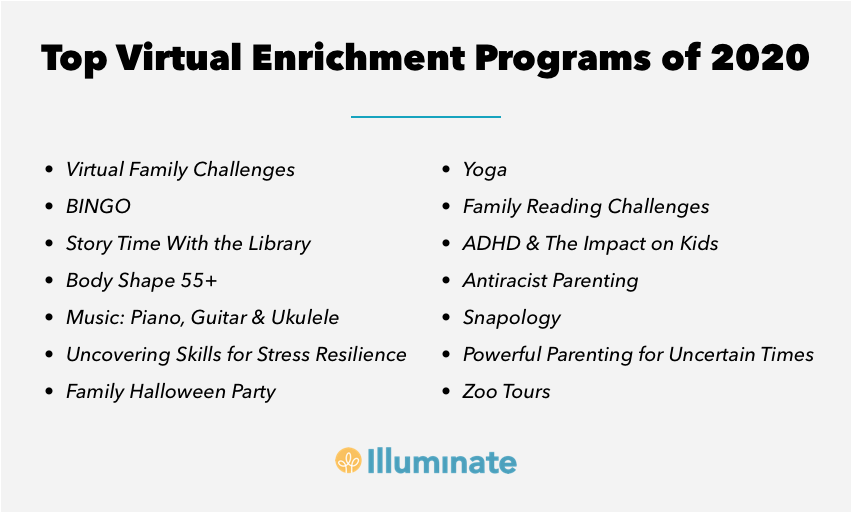
Rediscovering the great outdoors.
Despite the success of online courses, many programs received feedback from their communities that, essentially, after a full day of being in front of a screen, they wanted outdoor, socially distanced, in-person options for themselves or their children. For outdoor course offerings:
- Running clubs and ski & snowboard nights were popular options. Many communities formed these mainly solo activities into weekly clubs, offering a sense of community.
- Geocaching, backing, bonfires, stargazing, and other classes that adhere to social distancing measures, were also popular among the programs we surveyed.

With the rise of these new offerings and the return of some more familiar programming, it will be important to monitor registration and attendance data throughout the year to determine the blend of in-person, outdoor and virtual options your communities are looking for. Already, we’re seeing a significant amount of in-person options in some of the early summer program guides. But again, we believe a blend of in-person and the highly successful virtual options is here to stay.
“We’re planning more outdoor activities, no matter where we’re at with the pandemic. Families feel more comfortable being outdoors.”
Additional resources for enrichment.


Child care
Your community is online. Are you meeting them there?
A significant factor of a successful child care program is answering the question — does this work for my community? For 2021, one of the main opportunities we see with child care programs (that can help answer this question) is to optimize how they communicate to support their families learn and get excited about their programs!
The marketing and optimization strategies highlighted above are not exclusive to enrichment programs. Thoroughly audit how you’re communicating both information and excitement. After uncertainty and a year spent mostly at home, programs need to welcome parents and their children back.
Here are some tips to get started:
- Craft welcome messaging. We’ve all been through a challenging year. Develop warm, compassionate messaging for your community.
- Get creative with it! Help families get excited about your programs through fun messaging, visuals and videos using some of the marketing assets highlighted earlier.
- Outline any updated registration processes or schedules.
- Promptly display health and safety protocols to help build trust and ensure families your programs are the safest option for them.
- Develop an optimized web presence. This task has long-been shifting from luxury to necessity for the child care industry. Throughout 2020, we’ve learned, communicated and leaned on the web. Having your programs and information online provides you the best and tightest relationship with your community.
Additional steps to optimize your website. Make sure:
- Online registration sites/software and program pages are easy to access on district website
- Contact pages contain current information
- Confirmation emails and communications are sent to families who register/enroll
- Links to registration pages are prominent and accessible
- Policies and fees are accessible
- Tuition rates are clear to eliminate confusion
- All relevant information and links are placed on school or district website
Scheduling thoughtfully and strategically.
Remote, hybrid and entirely in-person: Odds are, your program facilitated all schedule types last year. Ensure your scheduling matches that of the parents in your district. Below, we’ve provided a simple checklist to ensure your program meets the needs of your families.
Evaluating Hours: Look at the relationship between last year’s attendance data and your start/end times. How much return did you receive on the staffing cost of those hours?
Scheduled vs. Attended: Closely review the correlation between dates scheduled and dates attended. Do they match, or do you have discrepancies? If the latter, it is an excellent opportunity to consider new schedule types.
Additionally, we’ve covered a few scenarios in child care scheduling last year that we believe will help guide scheduling decisions in 2021.


Faith in industry bounceback
The work starts now.
According to a Grand View Research report, the U.S. child care market size was valued at $54.3 billion in 2019. Despite the pandemic market setback, the value of the industry is still expected to maintain an annual growth rate of 3.9%. At this growth rate, the child care industry remains on track to achieve an estimated $73.8 billion value by 2027.
Out of this growth, Grand View Research estimates that the organized care facilities segment dominated the market and accounted for the largest revenue share in 2019. The segment is also expected to witness the fastest growth rate from 2020 to 2027. The rising number of working parents and growing demand for child care services is expected to drive the segment.
What do these projects tell us? With a general rising number of working parents, a continuing number of parents returning to the workforce, and an on-site workforce, the child care industry’s growth remains healthy, despite the setback of COVID-19.
What’s more encouraging is how leaders in both child care and enrichment comment on their learnings in 2020 and how they will respond to this new year with optimism and continued fortitude.
"While disruption can certainly present challenges, it can also present opportunities that we can capitalize on if we are prepared to do so.” —Michael Seppi, St. Louis, MO
One thing is clear, your communities' need for your programs will only continue to grow and as an industry, we have to grow alongside them. There is no better day to start preparing than today.



